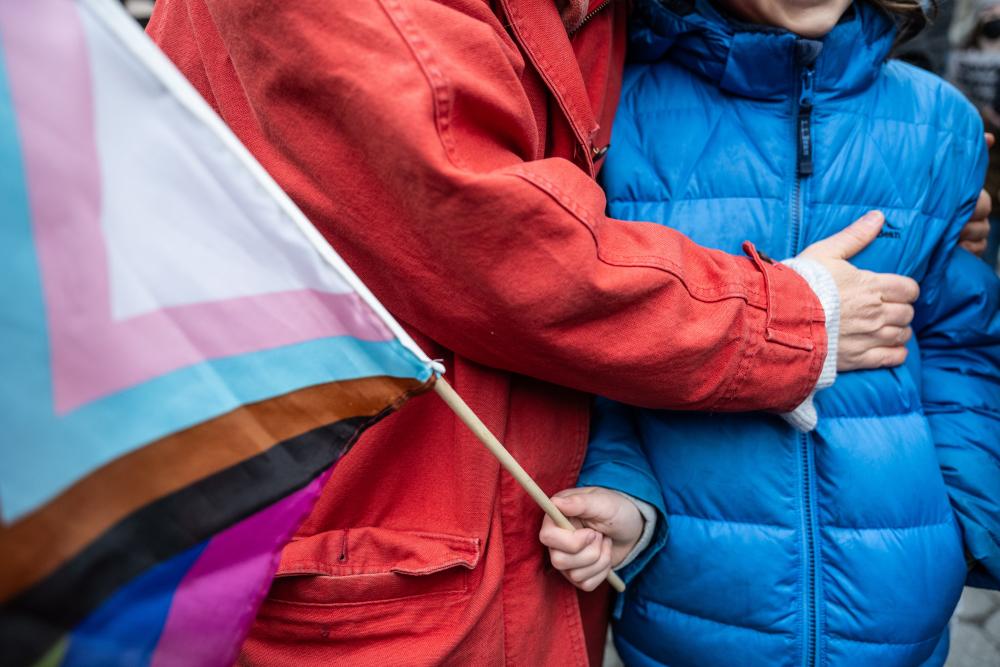Becca Nordeen had just left a town hall for the 988 Suicide & Crisis Lifeline when she received some shocking news. As the senior vice-president of crisis intervention at the Trevor Project, a non-profit focused on suicide prevention for queer youth, Nordeen’s team had provided counseling to LGBTQ+ individuals through 988, a national suicide and crisis hotline, for nearly three years. But a few minutes after the meeting, Nordeen received an email notifying her that those services would be terminated in a month.
“There’s an emotional hangover of dealing with the grief and the work of shutting down the program,” Nordeen said. “In the days and weeks that have followed, we have looked at, ‘well, there are still young people who need us, and in our remaining service, how can we be there to meet that need?’”
From 988’s inception, trained counselors had answered 1.5m online chats, calls or texts from LGBTQ+ youth in crisis. The Trevor Project was one of several groups contracted by the federal agency the Substance Abuse and Mental Health Services Administration (SAMHSA) to field calls from LGBTQ+ people, nearly 10% of the lifeline’s overall contacts. Nordeen’s team had responded to about half of the requests for services from the high-risk population. SAMHSA cited financial constraints as the reason for closing its line geared toward the LGBTQ+ community, though opponents of the closure say that it was politically motivated.
Related: Trans youth fight for care as California clinics cave to Trump: ‘How can this happen here?’
The 988 general hotline still exists and specialized services for veterans remain. But free, 24/7 counseling is no longer available for LGBTQ+ youth through the “press 3” option. According to 2023 survey data from the Centers for Disease Control and Prevention, 20% of queer youth attempted suicide between 2022 and 2023. They are more than three times more likely to do so than their cisgender and heterosexual peers.
Since the closure of 988’s LGBTQ+ services on 17 July, Nordeen said that the Trevor Project has been “picking up the pieces”. The closure of the 988 lifeline has also meant that the Trevor Project lost the $25m federal contract that allowed the non-profit to more than double its impact by reaching 270,000 people. More than 200 counselors from the Trevor Project were let go upon the national lifeline’s termination. But through donations from individuals and foundations, the non-profit retained 30 counselors who will join their privately funded 24/7 suicide prevention hotline that started in 1998.
Now, the Trevor Project has 130 counselors to answer the 20% surge in calls over the past two months. It’s too early to predict how long the influx will last, said Nordeen, but in the meantime, she wants youth to know that the non-profit is still there to help them. Over the past couple of weeks, Nordeen’s team has monitored the volume of requests and reached out to off-duty counselors and their network of more than 400 volunteers to respond to calls and texts during influxes.
More than 53,000 people signed the Trevor Project’s petition to protect the lifeline, some of whom shared their personal experiences using it. One signer from California wrote that it saved their child’s life during a mental health crisis last year, and another person from Pennsylvania wrote that they had used the service countless times and would not be here today without it.
“These youth resources make us the adults we are today,” a signer from New York wrote in the petition. “They’re not extras or luxuries, they’re lifelines. They’re the affirming spaces, the trusted adults … the moments where we were told: ‘You belong.’ Without them, many of us wouldn’t have made it.”
‘An erasure of a population’
A SAMHSA spokesperson told the Guardian in an email that the “press 3” option had run out of congressionally directed spending and that “continued funding of the Press 3 option threatened to put the entire 988 Suicide & Crisis Lifeline in danger of massive reductions in service”. Congress had appropriated about $519m for 988 in the 2025 federal fiscal year that began on 1 October 2024 and ends on 30 September 2025. The LGBTQ+ services were allotted $33m, which had been exhausted by June, SAMHSA said in a statement. “The 988 Lifeline will continue to be a direct connection to immediate support for all Americans,” the spokesperson said, “regardless of their circumstances.”
But Dr Sunny Patel, a child psychiatrist and former senior adviser for children, youth and families at SAMHSA, said that the agency was under pressure from the Trump administration to close 988’s “press 3” option to adhere to executive orders aimed at dismantling diversity, equity and inclusion initiatives. “One of the things that I find very challenging to believe is that it’s related to a lack of funding,” Patel said.
The National Suicide Hotline Designation Act of 2020, which created 988 and was signed into law by Donald Trump during his first term, specified that SAMHSA must be prepared to provide specialized services for LGBTQ+ youth. But now, the Trump administration has taken a special interest in targeting the healthcare of transgender individuals, Patel said. “They don’t want anything to do with LGBTQ populations,” he added. “There is this air of, ‘Well, everything should be for everybody, and so why should we have any specialized services for anybody?’”
Patel said that he believed that the agency was obliged to continue a lifesaving service, and that ending it would generate harm and confusion. “I fear for the direction that we’re going in,” Patel said, “where there’s an erasure of a population and its needs.”
Mark Henson, the Trevor Project’s vice-president of government affairs and advocacy, is hopeful that the decision will be reversed, in light of support from members of Congress who are pushing the Trump administration to reinstate the 988 lifeline. In the meantime, the non-profit is fundraising to try to hire more counselors to handle the potential for a continued surge in calls. And in July, California governor Gavin Newsom’s office announced that California would partner with the Trevor Project to train 988 counselors in the state to better serve LGBTQ+ youth.
“We’re trying to flood the zone in any way that we can, to the extent that resources allow us to keep these services going,” Henson said, and to ensure that “the LGBTQ+ youth know that there are services out there, that they belong, and that their life has value”.
‘What happens if there’s only one?’
When the announcement was made that the lifeline would be terminated, Henson heard from youth that they would use 988’s LGBTQ+ services as a backup if surges on the Trevor Project’s hotline prevented them from quickly accessing a counselor and vice versa. “If there was an increase in wait time on one line, they would go to the other. There was an equilibration there that enabled them to have these multiple options,” Henson said. Now, he said, youth are asking: “What happens if there’s only one?”
Specialized services from trained counselors provided a safe and affirming space for LGBTQ+ youth, Nordeen said, so that they felt less alone even if they did not have community or local support. “When you take that network away,” Nordeen said, “you are essentially invalidating that young person and their experiences and the crisis that they might feel.”
The specialized services were also effective because the counselors sometimes shared similar experiences as the callers and were better able to relate to those in crisis, said Hannah Wesolowski, chief advocacy officer at the National Alliance on Mental Illness (Nami), where she advocates for policies to help people affected by mental health conditions. Youth and LGBTQ+ people were the most aware of 988, she said, so she’s concerned that dropping services could lead to “tragic outcomes”.
Related: ‘Chipping away at democracy’: authors fear outcome of US supreme court’s LGBTQ+ book ruling
“I fear in this time of really heated political rhetoric and partisanship,” Wesolowski said, “that this is another message point that tells young people: ‘You’re not important, you’re not the priority.’”
Nami, the American Foundation for Suicide Prevention (AFSP) and other organizations are working with members of Congress to try to return funding to the lifeline in the 2026 fiscal year, or to pass legislation that would require specialized services for LGBTQ+ people. And from a state level, Nami’s local chapters are brainstorming with politicians on potential crisis service options for queer youth in their nearby communities.
For Bob Gebbia, the CEO of AFSP, an organization that researches suicide prevention and that advocated for the formation of 988, it is ironic that the specialized service that received widespread bipartisan support during its creation is now the subject of fierce debate. The argument for maintaining LGBTQ+ services is simple, he said: it’s based on need. “It isn’t a political issue,” he said, “it’s a public health issue.”
• In the US, you can call or text the National Suicide Prevention Lifeline on 988, chat on 988lifeline.org, or text HOME to 741741 to connect with a crisis counselor. In the UK, the youth suicide charity Papyrus can be contacted on 0800 068 4141 or email pat@papyrus-uk.org, and in the UK and Ireland Samaritans can be contacted on freephone 116 123, or email jo@samaritans.org or jo@samaritans.ie. In Australia, the crisis support service Lifeline is 13 11 14. Other international helplines can be found at befrienders.org

